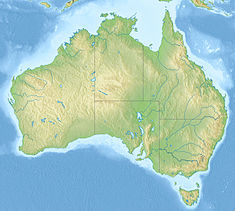
Paddington is an upscale Eastern Suburb of Sydney, in the state of New South Wales, Australia. Located 3 kilometres (1.9 mi) east of the Sydney central business district, Paddington lies across two local government areas. The portion south of Oxford Street lies within the City of Sydney, while the portion north of Oxford Street lies within the Municipality of Woollahra. It is often colloquially referred to as "Paddo".

Emu Plains railway station is a heritage-listed railway station located on the Main Western line in the western Sydney suburb of Emu Plains in the City of Penrith local government area of New South Wales, Australia. It was designed by the New South Wales Government Railways and built from 1884 to 1907 by M. Reed, et al. It is also known as Emu Plains Railway Station group. The property was added to the New South Wales State Heritage Register on 2 April 1999. The station is served by Sydney Trains' T1 Western line services and NSW TrainLink's Blue Mountains line services.

Lithgow railway station is a heritage-listed former station master's residence and railway station located on the Main Western line at Railway Parade, Lithgow, City of Lithgow, New South Wales, Australia. It was designed and built by New South Wales Government Railways and built from 1924 to 1925. It is also known as Lithgow Railway Station Group and Residence and Eskbank East. The property was added to the New South Wales State Heritage Register on 30 August 2013. The station has frequent NSW TrainLink services running to and from Sydney Central.
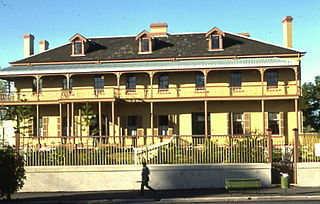
Juniper Hall, also known as Ormond House, is a heritage-listed former residence and children's home and now retail building and exhibition venue located at 1 Ormond Street, Paddington, Sydney, New South Wales, Australia. It was built from 1824 to 1825 by Robert Cooper. The two-storey Old Colonial Georgian house was added to the New South Wales State Heritage Register on 2 April 1999 and is listed on the Register of the National Estate

Kenilworth is a historic house in the Sydney suburb of Potts Point, New South Wales, Australia. Completed in 1869 in the Victorian Rustic Gothic Revival style, the sandstone house is now part of St Luke's Care.

The Paddington Town Hall is a heritage-listed former town hall building located at 249 Oxford Street in the inner eastern Sydney suburb of Paddington, in the City of Sydney local government area of New South Wales, Australia. Sir Henry Parkes laid its foundation stone in 1890 when Paddington was a separate municipality. It was designed by John Edward Kemp and built from 1890 to 1891, and remains a distinctive example of Victorian architecture in Sydney. The clock tower, completed in 1905, is 32 metres (105 ft) high and is a prominent landmark on the ridge of Oxford Street. It is also known as Town Hall and was added to the New South Wales State Heritage Register on 2 April 1999.
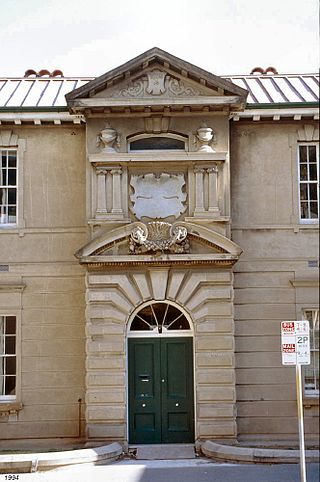
The Department of Primary Industries Building is a heritage-listed former public service building at 99 William Street, Brisbane City, City of Brisbane, Queensland, Australia. Prior to its adaptation for public service offices, it operated as the William Street Immigration Depot. It was added to the Queensland Heritage Register on 4 July 1995.

Our Lady of Assumption Convent is a heritage-listed former Roman Catholic convent at 8 Locke Street, Warwick, Southern Downs Region, Queensland, Australia. It was designed by Simkin & Ibler and built from 1891 to 1914. It is also known as Assumption College, Cloisters, and Sophia College. It was added to the Queensland Heritage Register on 21 October 1992.
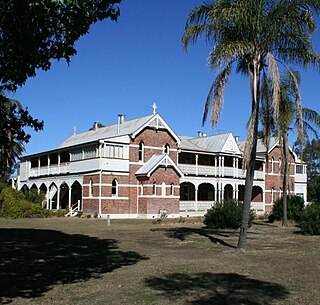
St Columba's Convent is a heritage-listed Roman Catholic former convent at 169 Cunningham Street, Dalby, Western Downs Region, Queensland, Australia. It was designed by George Bernard Roskell and built in 1913 by John Draney. It is also known as Iona. It was added to the Queensland Heritage Register on 9 December 2010.

Ipswich Grammar School Buildings are a heritage-listed group of private school buildings at Ipswich Grammar School, Woodend Road, Woodend, Ipswich, City of Ipswich, Queensland, Australia. They were built from 1863 to 1972. They were added to the Queensland Heritage Register on 21 October 1992.

The Paddington Post Office is a heritage-listed post office located at 246 Oxford Street in Paddington, a suburb of Sydney, Australia. The post office is owned and operated by Australia Post. The building was also a former telephone exchange. It was designed by the New South Wales Colonial Architect's Office under James Barnet and later Walter Liberty Vernon, and was built by William Farley. The building was added to the Commonwealth Heritage List, the New South Wales State Heritage Register on 22 December 2000, and the Register of the National Estate.
Casino Post Office is a heritage-listed post office at 102 Barker Street, Casino, in the Northern Rivers region of New South Wales, Australia. It was designed by the NSW Colonial Architect's Office and built from 1879. The property is owned by Australia Post. It was added to the New South Wales State Heritage Register on 23 June 2000.

Morpeth House and Closebourne House is a heritage-listed precinct containing two associated residences built by Edward Charles Close at 365 Morpeth Road, Morpeth, City of Maitland, New South Wales, Australia. It includes Morpeth House and Closebourne House. The houses were built from 1829 to 1849 and were added to the New South Wales State Heritage Register on 2 April 1999.

The Old King's School is a heritage-listed former campus of The King’s School, rehabilitation centre and office complex at O'Connell Street, Parramatta, Sydney, New South Wales, Australia. It was designed by various architects, including Ambrose Hallen, Blacket Brothers, Moorhouse & Isaacs and Power Adam & Munnings, and built by various contractors including C. A. Millyard and W. Noller. It is also known as The Old King's School and part of the site as Laurel House. It is now the Bayanami Public School. It was added to the New South Wales State Heritage Register on 2 April 1999.

Cobar Post Office is a heritage-listed post office at 47 Linsley Street, Cobar, New South Wales, Australia. It was designed by James Barnet in 1885. It was added to the Australian Commonwealth Heritage List on 22 August 2012.

Pyrmont Post Office is a heritage-listed former post office and now bank branch office located at 148 Harris Street, in the inner city Sydney suburb of Pyrmont in the City of Sydney local government area of New South Wales, Australia. It was designed by the Government Architect’s Office under Walter Liberty Vernon. The property is owned by Australia Post, an agency of the Commonwealth Government of Australia. It was added to the Australian Commonwealth Heritage List on 22 June 2004 and to the New South Wales State Heritage Register on 22 December 2000.

Louisaville is a heritage-listed residence at 2 Wells Street, Balmain, Inner West Council, Sydney, New South Wales, Australia. It is also known as Inglefield House. It was built by William Carss. It was added to the New South Wales State Heritage Register on 2 April 1999.
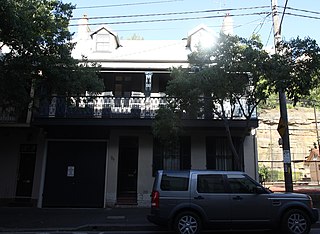
Toxteth is a heritage-listed residence located at 94 Kent Street, in the inner city Sydney suburb of Millers Point, New South Wales, Australia. It was added to the New South Wales State Heritage Register on 2 April 1999.

22 York Street, Sydney is a heritage-listed commercial office and former warehouse located at 22 York Street, in the Sydney central business district, in the City of Sydney local government area of New South Wales, Australia. It has now been incorporated into the Landmark Building development. The property is privately owned. It was added to the New South Wales State Heritage Register on 2 April 1999.

The Bulletin Place Warehouses are a series of three heritage-listed former warehouses and now souvenir sales office, commercial offices, health club, storage area, and restaurant located between 6–18 Bulletin Place, in the Sydney central business district in New South Wales, Australia. The warehouses were built from 1880 and have variously been known as the San Francisco Restaurant. The property is privately owned. It was added to the New South Wales State Heritage Register on 2 April 1999.


